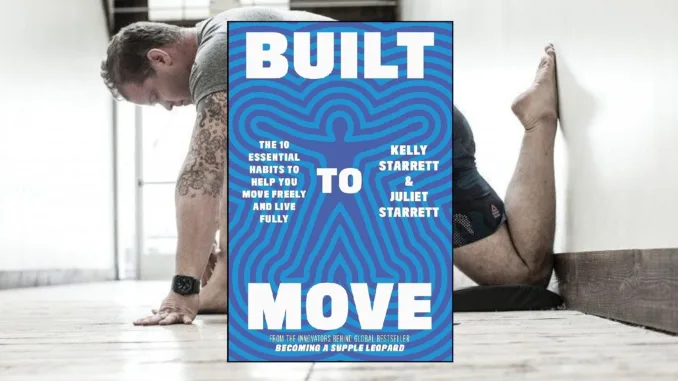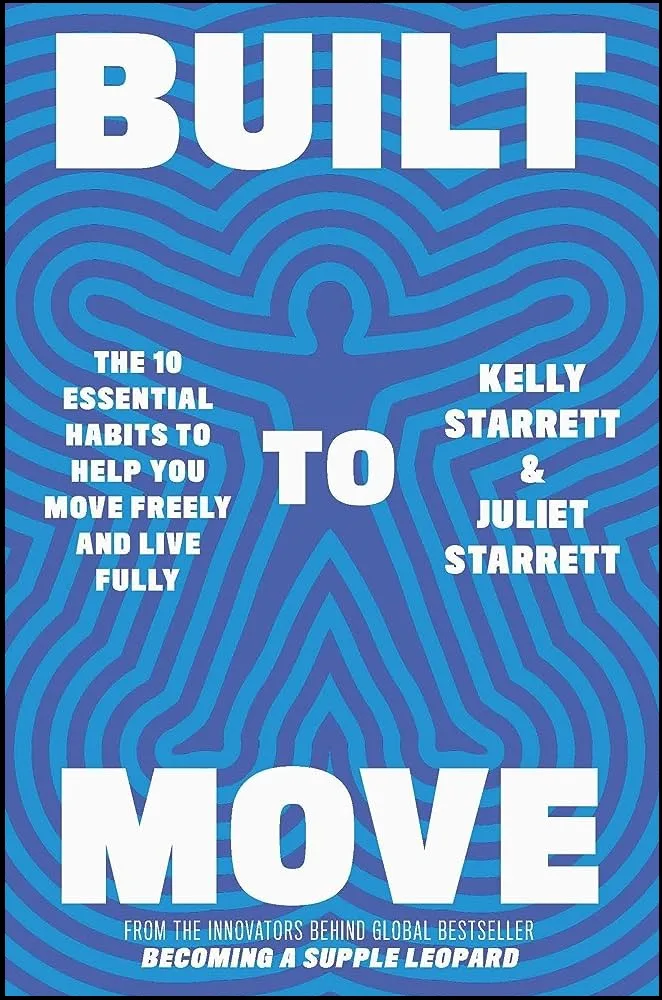
As someone with a copy of Becoming a Supple Leopard I’m happy to read anything authored by Kelly Starrett.
Built to Move sees Kelly team up with his wife Juliet for a health and fitness book aimed at the general population. Each chapter introduces one of the 10 “vital signs”, ways to assess your body’s current ability to function optimally. Every vital sign comes with tests and measurements as well as an explanation of why each one is considered important. You are then introduced to daily practices which will allow you to obtain a perfect score and, more importantly, allow your body to function at a higher level. It wouldn’t be a Kelly Starrett book without plenty of mobilisations and this book packs in 18 that you can incorporate to your weekly routine.
The book culminates in a 21 day Built to Move challenge. In the final chapter the authors demonstrate how all the practices fit together across a 21 day plan. The 21 day challenge is actually available on their website and you can find day one here.
Note: while I do recommend the book, there were one too many anecdotes and it felt quite padded in places. At 280 pages, I would have liked to see them cut out the fluff and present a handy guide in 150 pages or less. An alternative to purchasing the book would be to follow the 21 day challenge (linked above) and only buy the book if you feel something was missing.

PRO TIP: Take notes! When you read a book, use a blank sheet of paper as a bookmark. Write down any interesting facts and information from the book. This condenses a whole book into 3-4 pages of key notes that are important and relevant to you.
My Notes on Built to Move
Getting up and down off the floor
- The sit and rise test determines hip range of motion, leg and core strength, balance and coordination.
- The daily practice is to accumulate at least 30 minutes a day sitting on the floor.
Breathe easy
- The body oxygen level test (BOLT) determines CO2 tolerance.
- The daily practice is nasal breathing. This releases nitric oxide, a vasodilator, enabling 18% more oxygen to flow to your cells
- For a more in-depth understanding of the importance of nasal breathing, read Breath by James Nestor.
Extend your hips
- If you follow Kelly Starrett, it’s no surprise that both the test and the daily practice for hip extension is the couch stretch.
- A deficit in hip extension will cause the toe to turn outwards. This in turn reduces the big toe push off you get while walking/running.
Walk this way
- For this vital sign, the assessment and physical practice is walking 8-10k steps a day. For those without a tracker, this equates to around 4-5 miles, but around half that may come from general daily activity.
Future-proof your neck and shoulders
- There are two tests here, both aimed at shoulder and upper body mobility. Instructional videos of these tests can be found on day 5 of the 21 day challenge.
- For a daily practice, it’s a series of mobilisations like the Wall hang, T-Spine and Rotator cuff.
Eat like you’re going to live forever
- Once again, the test and physical practice are one and the same. That is to consume 800 grams of fruit and vegetables per day. Additionally, 0.7 to 1 gram of protein per lb of body-weight, which is 1.65-2.2 grams per kg.
- The 800 gram count was lifted directly from a nutrition coach named EC Synkowski. There are “rules”, such as dried fruits or fried vegetables not counting, while potatoes and legumes do count.
Squat
- For this vital sign, you need to be able to complete a full squat. You also improve it by squatting daily and hanging out in a deep squat position. This is the first topic touched on in Kelly’s famous MobilityWOD series on YouTube, seen below.
Find your balance
- To assess your balance, stand on one leg with your eyes closed for 20 seconds. Every time you need to touch the floor, add a point. Ideally you would score 0.
- If you view the Physical Practice tab on day 8, there you can see a walkthrough of the Y-Balance practice.
Create a movement-rich environment
- Taking a three day average, a “pass” would be to spend no more than 6 hours per day sitting. Sitting on the floor or while exercising e.g. rowing or cycling, is not counted.
- A study showed that sitting 6+ hours a day increases risk of dying by 37% in women and 18% in men vs those sitting < 3 hours a day, after controlling for exercise
- The daily practice is to become more conscious of the time you spend sitting, and try to invest in a standing desk if required. For readers in the UK, I purchased an electric standing desk from Fezibo for under £200 and I’m happy with it.
Unleash your superpower – Sleep
- Another book that will help highlight the importance of this vital sign is Why We Sleep by Matt Walker. The test here is to track your average sleep for 3 nights (a wearable really comes in handy here) and aim to be above 7 hours.
- The daily practice is everything you’ve already been told about good sleep. A more practical guide to sleep is the book Sleep Smarter by Shawn Stevenson. Recommendations include avoiding blue light and late caffeine, sleeping in a dark and cool room, and having consistent sleep and wake times.
21 Day Built to Move Challenge
I am two days away from completing the 21 day built to move challenge. I’m relatively healthy so I didn’t need to change too much about my daily living to tick all the boxes. I’ve found the mobilisations easy to slip in to my morning routine though they’ve varied in effectiveness.
While the 10k steps target is very generic and has been criticised elsewhere, it at least allowed me to identify days in which I’m almost entirely sedentary. A 15-20 minute walk after breakfast has been good for both my blood sugar regulation and my step count, so it’s a welcome addition to my routine.
I’ve been less positive about the 800 grams of fruit and vegetables. I already have a hefty portion of oatmeal in the morning and the total fibre that comes with 800 grams of fruit and vegetables (some days were 60 grams or more) left me feeling bloated and uncomfortable. The target is introduced on day 6 and by 12 I found myself having to back off and give my body a rest. I had a large portion of broccoli for dinner on day 11 and the slow digestion severely disrupted my sleep. I would warn against people trying to jump straight into 800 grams if their body isn’t used to it. I now aim for 600 grams, which is 50% higher than I was previously getting.
Lastly, a note on the standing desk. I’ve had one in the past and have either used it too little or too much. The 21 day challenge strikes a really nice balance. It starts out at 30 minutes/day of standing desk and adds 10 minutes each day. As I finish up this article I’m passing the 130 minute mark which was the target for day 19. This was a achieved in three spells of 30-60 minutes broken up by periods of sitting.
As I said above, following the links to the 21 day challenge will be enough for most people to improve their health. If you do purchase the book, don’t be afraid to skip the anecdotes, the level of writing is quite poor and it’s not the reason people should read this book.

